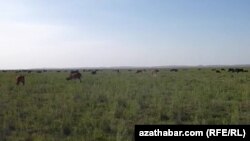
RFE/RL's Turkmen Service, Azatlyk, has been following events along the Turkmenistan-Afghanistan border for several months now, describing the situation of the Afghan Turkmen and their relationship with Turkmenistan.
For the last few years neither was very good.
Azatlyk produced a series of reports from one of the villages on the Afghan side of the border, where residents have repeatedly complained that the river that divides Afghanistan from Turkmenistan in their area, the Amu Darya, is pushing southward, eating away their arable land and forcing them to move into the harsh desert.
They also protested that islands that have risen emerged in the middle of the Amu Darya, once part of Afghan land, were off-limits to them and their animals as Turkmen border guards regularly arrested and jailed Afghan Turkmen found on these islands.
After Azatlyk's reports, at the end of March, amid Norouz festivities in Kabul, Afghan Turkmen tribal elders met with Turkmenistan's Foreign Minister Rashid Meredov to plead for the Turkmen government's help in stopping the southerly push the Amu Darya and resolve the problem of use of the islands.
Meredov promised help would come but it was not clear at that time when that and might arrive.
Abdukadyr Maliya of the Jowzjan provincial council told Azatlyk a delegation from Turkmenistan arrived on the Afghan side of the border, in the Khamyab district, on April 16.
Maliya said officials from Turkmenistan's Lebap Province, including the provincial prosecutor's office, and from Turkmenistan's border guards met with officials from Afghanistan's Qarqeen and Khamyab districts. A memorandum was signed laying out the basic terms of future aid.
Turkmenistan will help build a retaining wall along 30 kilometers of the Amu Darya bank in the Qarqeen district and 16 kilometers in the Khamyab district to prevent the river from devouring any more of the land on the Afghan side of the border.
Additionally, the Afghan Turkmen are now able to bring their cattle to a large island to graze.
It was unclear if there was any progress in freeing Afghan Turkmen imprisoned in Turkmenistan after being caught on these islands, but the presence of representatives of the Lebap prosecutor's office perhaps indicates the topic was discussed at the meeting.
And, according to Abdukadyr Maliya, the Turkmen government delegation promised to resume sending electricity to villages on the Afghan side of the border. Maliya could not say exactly when that would happen but he did say it would be "soon."
-- Bruce Pannier, with contributions from Muhammad Tahir of RFE/RL's Turkmen Service
For the last few years neither was very good.
Azatlyk produced a series of reports from one of the villages on the Afghan side of the border, where residents have repeatedly complained that the river that divides Afghanistan from Turkmenistan in their area, the Amu Darya, is pushing southward, eating away their arable land and forcing them to move into the harsh desert.
They also protested that islands that have risen emerged in the middle of the Amu Darya, once part of Afghan land, were off-limits to them and their animals as Turkmen border guards regularly arrested and jailed Afghan Turkmen found on these islands.
After Azatlyk's reports, at the end of March, amid Norouz festivities in Kabul, Afghan Turkmen tribal elders met with Turkmenistan's Foreign Minister Rashid Meredov to plead for the Turkmen government's help in stopping the southerly push the Amu Darya and resolve the problem of use of the islands.
Meredov promised help would come but it was not clear at that time when that and might arrive.
Abdukadyr Maliya of the Jowzjan provincial council told Azatlyk a delegation from Turkmenistan arrived on the Afghan side of the border, in the Khamyab district, on April 16.
Maliya said officials from Turkmenistan's Lebap Province, including the provincial prosecutor's office, and from Turkmenistan's border guards met with officials from Afghanistan's Qarqeen and Khamyab districts. A memorandum was signed laying out the basic terms of future aid.
Turkmenistan will help build a retaining wall along 30 kilometers of the Amu Darya bank in the Qarqeen district and 16 kilometers in the Khamyab district to prevent the river from devouring any more of the land on the Afghan side of the border.
Additionally, the Afghan Turkmen are now able to bring their cattle to a large island to graze.
It was unclear if there was any progress in freeing Afghan Turkmen imprisoned in Turkmenistan after being caught on these islands, but the presence of representatives of the Lebap prosecutor's office perhaps indicates the topic was discussed at the meeting.
And, according to Abdukadyr Maliya, the Turkmen government delegation promised to resume sending electricity to villages on the Afghan side of the border. Maliya could not say exactly when that would happen but he did say it would be "soon."
-- Bruce Pannier, with contributions from Muhammad Tahir of RFE/RL's Turkmen Service






